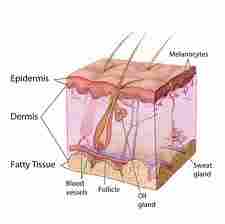I thought it would be a good idea to go back to basics and look at the skin itself because the key to ‘optimum skin health’ (My’ mission for all!) is knowing and understanding the inner workings of this dynamic organ.
Some interesting facts:
The Skin is the largest organ of the body with multiple layers, structural proteins, and vital components responsible for its health and appearance.
Adults carry 8 pounds and 22 square feet of it (Wow!).
This fleshy covering does a lot more than just make us look pretty, it covers and protects everything inside our body. Without skin, our muscles, bones, and organs would literally be falling out! (Yuk). Our skin holds everything together nicely, so it’s vital that we look after it.
The Skin is composed of three primary layers:
The surface is the epidermis.
This consists mainly of the protein Keratin (also the material in hair and nails). It forms several layers that constantly grow outwards/upwards, as the top surface cells die and flake off.
It takes roughly five weeks for new skin cells to work their way to the surface from the deeper levels.
This epidermis varies in thickness considerably – it is more than ten times thicker on the soles of the feet than around the eyes.
The epidermis also contains defensive cells, which alert the body’s immune system to viruses and other infectious agents. When activated we see redness, feel heat etc.
The epidermis is bonded to a deeper skin layer below it known as the dermis, which gives strength and elasticity thanks to fibers of collagen and elastin.
Blood vessels here in the dermis help regulate body temperature by increasing blood flow to the skin to allow heat to escape, or by restricting the flow of heat when it’s cold.
The dermis also has a network of nerve fibers, receptors pick up feelings such as touch, temperature and pain, relaying them back to the brain.
The dermis also houses hair follicles and glands with ducts that pass up through the skin. These sweat glands bring down internal temperature through perspiration while ridding the body of the waste fluids and also play a role in moisturising our skin.
Apocrine glands, which develop during puberty, produce a scented sweat linked to sexual attraction that can also cause body odor, especially around the armpits.
The skin’s base layer is the fat laid down as a fuel reserve in case of food shortage. It also works as insulation and cushions us from knocks and falls.
As you can see our skin has many functions and should be looked after properly.
Our skin is in direct contact with our environment, and it plays a key role in protecting the body against germs and excessive water loss. Its other functions as mentioned above are insulation, temperature regulation, sensation, synthesis of vitamin D, and the protection of vitamin B.
Ok, so now that we’ve discussed the anatomy and physiology of the skin we can move onto how we can look after it for Optimum Skin Health!
Look out for our next blog ‘Skin Fundamentals #2′
If you have any questions or would like to book in for a consultation drop me a line: contact@theskinnurse.co.uk or call me on: 07779113416
